DDR5 Demystified - Feat. Samsung DDR5-4800: A Look at Ranks, DPCs, and Do Manufacturers Matter?
by Gavin Bonshor on April 7, 2022 8:00 AM EST- Posted in
- Memory
- Intel
- Samsung
- Micron
- SK Hynix
- DDR5
- Alder Lake
- DDR5-4800
- 12th Gen Core
- Z690
CPU Performance Benchmarks: DDR5-4800
To show the performance of DDR5 memory in different configurations, we've opted for a more selective and short-form selection of benchmarks from our test suite. This ranges from tests on application opening, rendering, web, and compression.
All of the tests were run with all of the memory at default (JEDEC) settings, which means DDR5-4800 CL40, regardless of the configuration, e.g, 2x16, 2x32, and 4x16 GB.
Web: Speedometer 2
Our web test for this analysis is Speedometer 2, which is a test over a series of JavaScript frameworks to do three simple things: built a list, enable each item in the list, and remove the list. All the frameworks implement the same visual cues, but obviously apply them from different coding angles.
Our test goes through the list of frameworks, and produces a final score indicative of ‘rpm’, one of the benchmarks internal metrics.
We repeat over the benchmark for a dozen loops, taking the average of the last five.
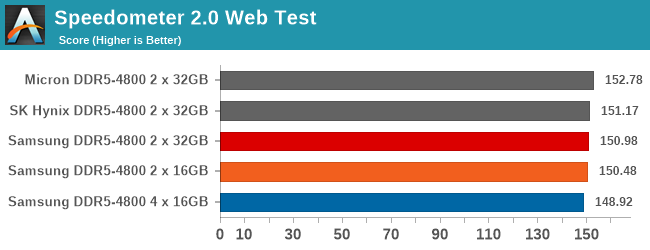
In Speedometer, the 2Rx8/1PDC DDR5-4800 kit performed best of all out of the Samsung memory, with the 1Rx8/1DPC performing closely behind the 2 x 32 GB kit. The 1Rx8/2PDC (4 x 16 GB) kit from Samsung technically performed the slowest of all, but the performance difference was within a 3% margin of error from top to bottom.
The Micron 2 x 32 GB proved the best out of all the memory we tested, albeit without much difference from the rest of the 2 x 32 GB kits tested.
AIDA64: 6.60: link
AIDA64 Extreme has a hardware detection engine unrivaled in its class. It provides detailed information about installed software and offers diagnostic functions and support for overclocking. As it is monitoring sensors in real-time, it can gather accurate voltage, temperature, and fan speed readings, while its diagnostic functions help detect and prevent hardware issues. It also offers a couple of benchmarks for measuring either the performance of individual hardware components or the whole system. It is compatible with all 32-bit and 64-bit Windows editions, including Windows 11 and Windows Server 2022.
We are using AIDA64 in this instance to gather memory bandwidth data based on read speed, write speed, copy speed, and memory latency.
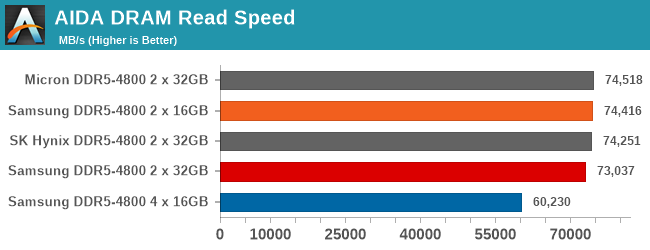
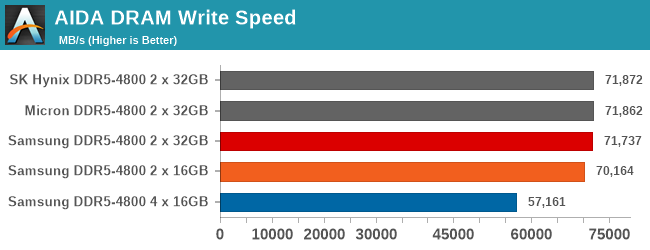
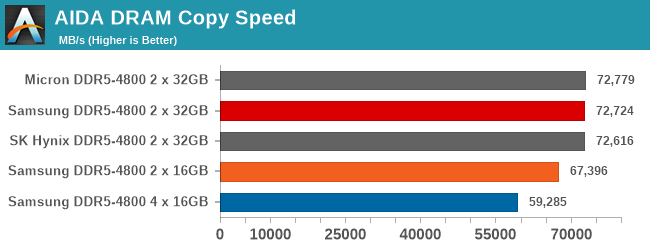
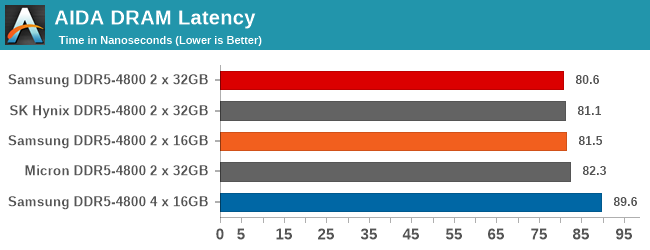
Looking at raw memory benchmarks from AIDA64, all of the 2 x 32 GB kits perform competitively against each other. Meanwhile the Samsung 4 x 16 GB experienced drops in performance across the board, with both read bandwidth and write bandwidth being impacted. There's also a notable latency penalty to consider when using four DIMMs (2DPC) versus two DIMMs (1DPC).
The most interesting result here may very well be the Samsung 2 x 16 GB (1Rx8) kit. While it's fully competitive with read speeds, it loses just a little bit of ground on write speeds, and a little more ground on all-out copies. In what's admittedly a memory-focused test, it's a very early indicator that dual ranked DIMMs are the sweet spot in terms of performance, and that losing a rank does incur penalties. All of which is then further exacerbated by going to 2DPC.
WinRAR 5.90: link
Our WinRAR test from 2013 is updated to the latest version of WinRAR at the start of 2014. We compress a set of 2867 files across 320 folders totaling 1.52 GB in size – 95% of these files are small typical website files, and the rest (90% of the size) are small 30-second 720p videos.
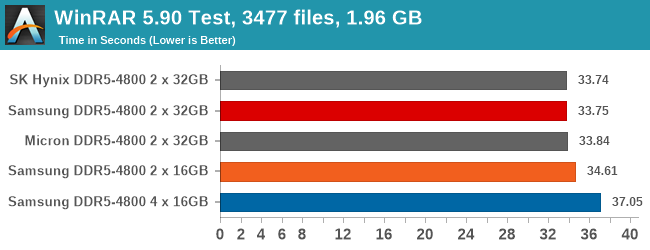
Looking at performance in WinRAR, this is where the higher density 2Rx8 memory showed its dominance. The kits with 16 Gb chips in 2Rx8 outperformed the 16 Gb 1Rx8, with the 2 x 16 GB Samsung kit notably outperforming the same memory running with four UDIMMs in a 2DPC configuration.
Rendering - Blender 2.79b: 3D Creation Suite
A high-profile rendering tool, Blender is open-source allowing for massive amounts of configurability, and is used by a number of high-profile animation studios worldwide. The organization recently released a Blender benchmark package, a couple of weeks after we had narrowed our Blender test for our new suite, however their test can take over an hour. For our results, we run one of the sub-tests in that suite through the command line - a standard ‘bmw27’ scene in CPU only mode, and measure the time to complete the render.
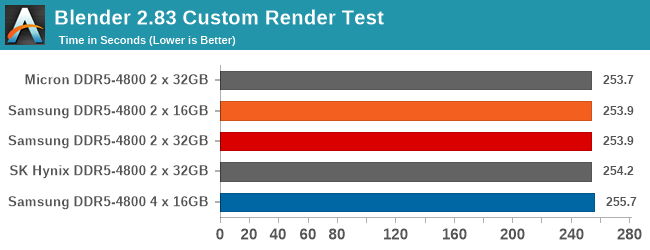
Focusing on rendering, the difference between the 2 x 32 and 2 x 16 GB kit was marginal. The 4 x 16 GB Samsung kit was technically the worst performer out of the bunch, but for all practical purposes, all 5 kits may as well be tied.
Rendering - Cinebench R23: link
Maxon's real-world and cross-platform Cinebench test suite has been a staple in benchmarking and rendering performance for many years. Its latest installment is the R23 version, which is based on its latest 23 code which uses updated compilers. It acts as a real-world system benchmark that incorporates common tasks and rendering workloads as opposed to less diverse benchmarks which only take measurements based on certain CPU functions. Cinebench R23 can also measure both single-threaded and multi-threaded performance.
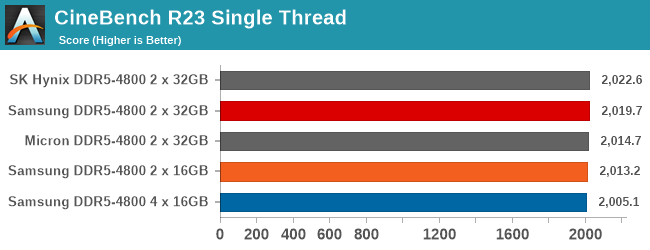
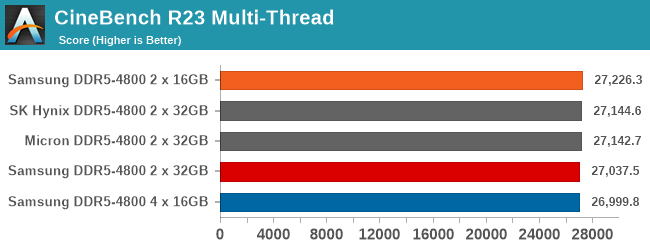
Using CIneBench 23, there wasn't much difference between the 2 x 32 GB kits in the single-threaded test. In the multi-threaded test, the Samsung 2 x 16 GB kit actually performed better than the 2 x 32 GB kits, underscoring how all of the kits are essentially tied in this workload.
Rendering – POV-Ray 3.7.1: Ray Tracing - link
The Persistence of Vision Ray Tracer, or POV-Ray, is a freeware package for as the name suggests, ray tracing. It is a pure renderer, rather than modeling software, but the latest beta version contains a handy benchmark for stressing all processing threads on a platform. We have been using this test in motherboard reviews to test memory stability at various CPU speeds to good effect – if it passes the test, the IMC in the CPU is stable for a given CPU speed. As a CPU test, it runs for approximately 1-2 minutes on high-end platforms.
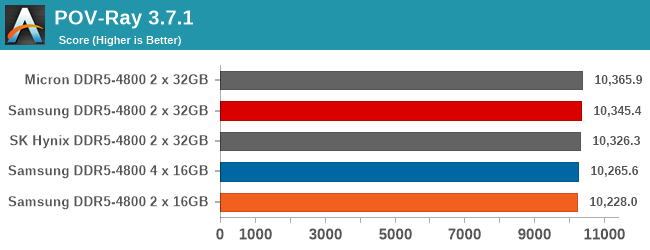
In our POV-Ray testing, the Micron kit performed slightly better than the rest, with Samsung's 2 x 32 GB kit coming a close second. Both variations tested with the 16 GB sticks were slightly behind its higher density counterparts. There was around a 0.36% hit in performance when using four 16 GB memory sticks versus using two.


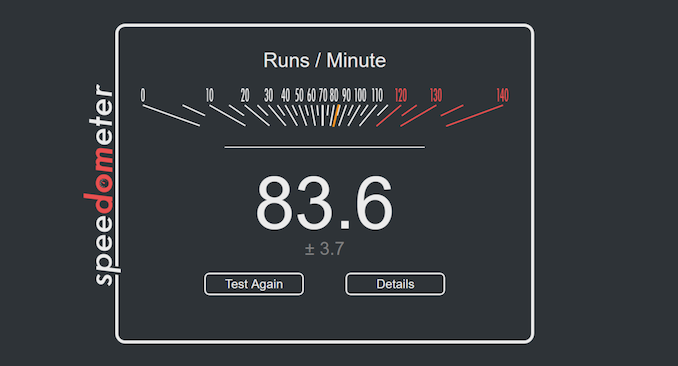








66 Comments
View All Comments
DanNeely - Friday, April 8, 2022 - link
2DPC is much harder on the signal integrity; and only gets worse the higher the clock rate is. To the extent that several years ago there was some public speculation that DDR5 might not be able to support 2DPC at all.DanNeely - Thursday, April 7, 2022 - link
Secondary/tertiary timings generally need to be loser in 2DPC mode. The 4 dimm kit almost certainly has them set looser from the factory in XMP. Without using that (or if you combine a pair of 2 dimm kits) I'm not sure if official JDEC timings or the default BIOS behavior adjusts them down automatically or if you end up overclocking your memory trying to hold the tighter values. OTOH in the OCed timing case I'd expect it to either be about as fast as 1DPC or have stability problems (unless you're using high end modules and not taking advantage of the faster XMP settings for some reason).repoman27 - Friday, April 8, 2022 - link
AFAICT, we don't even know the primary timings here.It looks like the Crucial 2x 32GB kit was the only one in the test that had any XMP profiles. But we have no idea if the firmware defaults resulted in those being ignored, used, or possibly even used in conjunction with Intel Dynamic Memory Boost Technology. I believe Alder Lake also has System Agent Geyserville (SAGV), which is another mechanism that could potentially dynamically alter memory frequencies.
Ryan Smith - Thursday, April 7, 2022 - link
Gavin's out for the rest of the day. But once he's back in, we'll check and see if we have logs of those figures so that we can publish exactly what they were.Slash3 - Thursday, April 7, 2022 - link
That would be perfect. I suspect that the four DIMM kit was being set to looser tertiaries automatically by the BIOS, and it would be interesting to see a full ZenTimings / ASRock Timing Configurator style readout for each kit arrangement. The gap in tested bandwidth seems far too high to be a result of rank variance, even for DDR5.The Z690 compatible version of Timing Configurator can be had from the HWBot community page.
https://community.hwbot.org/topic/209738-z690-bios...
alphasquadron - Thursday, April 7, 2022 - link
I may be wrong but the Grand Theft Auto benchmark titles for 1080p and 4k may need to be reversed as it shows 4k low mode having 80 more fps higher fps 1080p max mode.tomli747 - Thursday, April 7, 2022 - link
"The R in the 1Rx8 stands for rank, so 1Rx8 means it has one rank with eight memory chips per rank. "I thought x8 means each IC correspond to 8 bit of the bus, so 1Rx16 only need 4 ICs to form a 64bit rank.
stickdisk - Thursday, April 7, 2022 - link
Please do overclocking. I understand why you don't think it proper to do so but I really want a trusted source to settle the debate between Samsung and Hynix for DDR5 OC. I have a feeling they are actually the same but the OC community has fallen for the idea that Hynix is better.Also please look into clearing up whether higher XMP kits are just price segmentation tactic for memory vendors to make more money or are actually better binned. I'm sure they are better binned at times but I am also fairly confident they charge more for what is just a kit with an OC and not a better bin. This information could help people save some money.
Getting information of memory IC differences being the biggest indicator of potential memory performance into the mainstream is invaluable. This is important because I see way to many people building $2000+ PCs worrying about CPU OC for up to 5% more performance and not worrying about RAM OC for up to 10% more performance. Mainstream people don't have their priorities straight because mainstream tech influencers don't know better.
Oxford Guy - Thursday, April 7, 2022 - link
The benefit of XMP is that ordinary people don't have to try to do manual RAM overclocking, which is too complicated to be worthwhile for most people — especially on less-expensive boards that simply refuse to post and require guesses and manual CMOS clearing with a screwdriver. If one has the luxury of a fancy board with highly-specific post codes on a display, a CMOS reset button on the back panel (and, optimally, the ability to simply switch to a different profile), and reliable bypass of unstable RAM settings automatically by the board (preventing no-post situations) it might be worth doing for some enthusiasts. I suppose some of the new software configuration programs help to reduce the pain of RAM tinkering. I would rather switch on XMP and that's that, particularly when the RAM vendor promises it will work with the board I'm using at that speed.Oxford Guy - Thursday, April 7, 2022 - link
With DDR4 there is a difference between a daisy chain layout and a T topology layout, in terms of which layout is optimal with 2 sticks of RAM (daisy) and which is optimal with 4 (T). Does that model continue with DDR5? Which layout does this MSI board use and have you tried the other layout to verify that the board layout is not a factor?